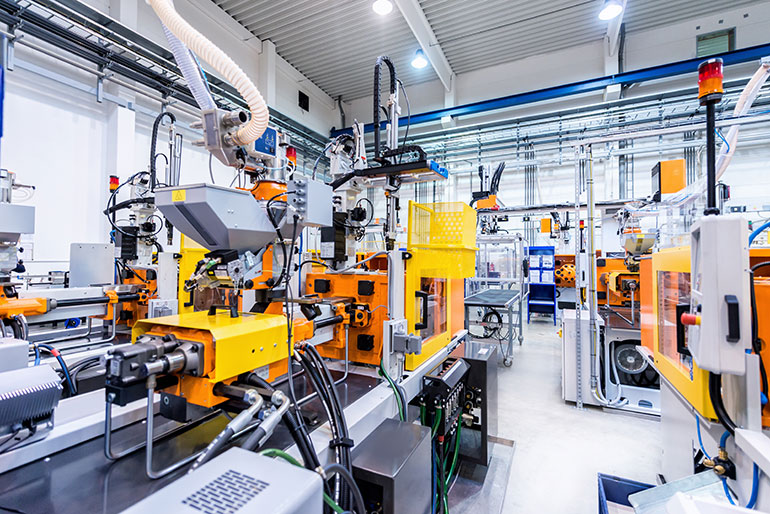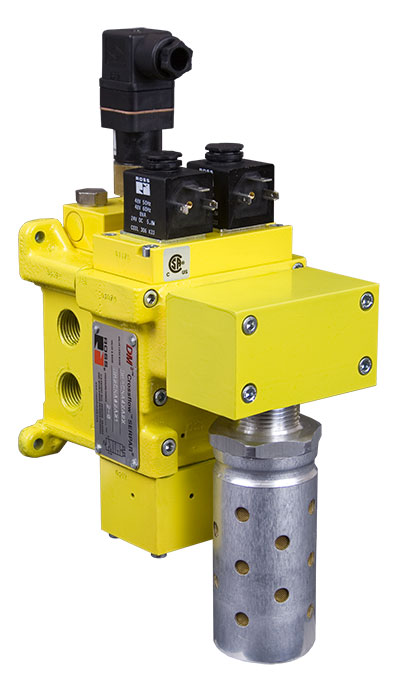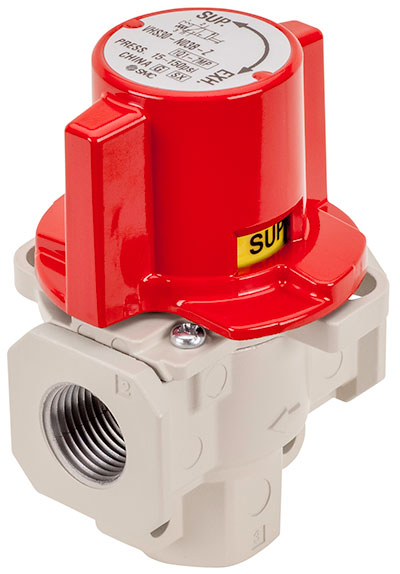Pneumatic safety valves, including bleed-and-block designs and 3/2 valves, are essential in manufacturing.
Pneumatic systems are known for their ability to rapidly employ compressed gas to achieve work, and in fact, it’s this element that makes pneumatics the top choice for high-speed actuation of machinery. The pneumatic press, for example, is capable of rapid movement with relatively high force, suitable for stamping, forming or punching through any material up to and including steel.

Image courtesy of istockphoto.com
With such a capacity to make plastic, aluminum or even steel yield to fluid power authority, you can imagine how human flesh would afford little safeguard against accidental interaction with pneumatic actuators. A punch press would care as much if your hand was in its way as much as it would a hunk of plasticine.
Safety is a top priority to any machine builder, especially where the potential for human interaction with such a machine is common. A punch press, for example, requires the loading and unloading of parts. If that process is manual rather than automated, it provides the opportunity for the machine operator to place their hands in the path of danger. There are codes and standards too lengthy to discuss here, but if a machine moves too quickly and across enough of a gap, provisions for safe machine operation must be put into place.
A safe machine is one that prevents the possibility of harm should the operator — or their body parts — enter a dangerous location, such as space in a press between the tooling and the workpiece. It’s common practice to use a light curtain fixed between the operator and work area, which when its beam is broken, defaults the machine into its safe mode.
Block-and-bleed safety
When a pneumatic press is faulted, two things must occur. The machine must first stop immediately from executing its press function, hopefully before harm occurs. Also, during such a machine fault, accidental reactivation of the actuator(s) must be prevented. The term block and bleed is colloquially applied to components capable of both blocking off the incoming air supply and also bleeding off work side pressure to prevent possible actuator movement.

Figure 1. The DM2 series valve from Ross Controls is a 3-way, 2-position normally closed valve that blocks primary inlet pressure from reaching downstream, while ensuring that downstream pressure is vented to atmosphere.
The block-and-bleed concept is so effective that various manufacturers such as SMC and Ross Controls make pneumatic safety valves that practice the concept as a specialty. The Ross Controls DM² Series valve (figure 1) employs multiple features to prevent energy from reaching a downstream actuator either intentionally or accidentally.
The valve block is essentially a 3-way, 2-position normally closed valve that blocks primary inlet pressure (either from the main receiver or a subcircuit at the machine) from reaching downstream, while keeping that downstream pressure vented to atmosphere. Mounting this valve at the supply of air to a machine, zone, or cell will provide a control reliable method of block and bleed.
The valve assembly consists of nearly a dozen internal valve components but can be best described as two pilot-operated 3-way, 2-position normally closed valves but with a crossflow arrangement. This means the supply to outlet paths are in series but outlet to exhaust paths are in parallel. Because of this arrangement, they must both be activated to allow flow from the inlet to outlet. If one valve or other fails to shift, no flow can occur. Control power is required for both solenoid valves simultaneously or the valve faults and must be reset.
Should only one of the two valves shift, the air is vented to the atmosphere, providing an audible signal that there is a problem. Until the valve is reset the assembly remains in safe mode while air is vented to atmosphere. Only when power is removed from the active coils can the manual reset be activated to allow the valve to function once again.
An additional feature of the safety valve is its ability to prevent activation when it senses low inlet energy from either low flow or pressure. When the incoming pressure is not high enough while the valve is energized the valve will fault but it cannot be reset until pressure is restored and the main coil signals removed. This is a safety function that ensures that only actuating the main coils can cause air to be supplied to the machine.
3/2 safety valves for maintenance
More simply, but no less important, are pneumatic lockout valves, such as the SMC VHS series in Figure 2. This is referred to as a pressure relief valve, but it’s essentially a 3-way, 2-position valve that manually vents downstream air to atmosphere. It provides a similar block and bleed function as the Ross DM², but obviously with less complexity.

Figure 2. The SMC VHS series is a pneumatic lockout valve. This 3-way, 2-position valve manually vents downstream air to atmosphere and provides a lockout feature for technicians.
A 3/2 safety valve is often used for maintenance purposes to prevent accidental machine operation when a technician is servicing the machine. Once the machine is shut down and ready for service, the technician rotates the knob to block incoming air supply, but also direct any or all downstream air out the bottom exhaust port. This ensures no residual pressure is capable of accidentally powering downstream actuators.
To guarantee technicians are protected during servicing, the valve is constructed with locking holes, allowing them to “lockout” the valve with their own padlock, to which they hold the only key. This practice is common with electrical panels but is becoming more popular as people realize the potential for harm with compressed air.
Although not self-monitored like the DM² Series, indicator windows show personnel if the downstream port is connected to the supply or vented to the exhaust. To prevent accidental turning of the handle, it must first be pressed downward before turning, similar to a childproof prescription bottle.
The safety valve can be installed at every airline drop, at machine FRLs or even at receiver outlets, should safety be the top concern. With ports up to 1 in. diameter, a CV over 8 provides more than 60 scfm – serious flow for the majority of applications.
The potential for injury exists in nearly every pneumatic machine, so safety must be taken seriously to prevent harm. Intelligent design must apply not only to cycle times and efficiency but also to the safe control of all functions. To this end, safety valves are absolutely essential.
Ross Controls
rosscontrols.com
SMC
smcusa.com
Filed Under: Pneumatic Tips